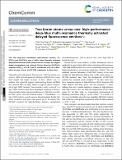Files in this item
Two boron atoms versus one : high-performance deep-blue multi-resonance thermally activated delayed fluorescence emitters
Item metadata
| dc.contributor.author | Chan, Chin-Yiu | |
| dc.contributor.author | Madayanad Suresh, Subeesh | |
| dc.contributor.author | Lee, Yi-Ting | |
| dc.contributor.author | Tsuchiya, Youichi | |
| dc.contributor.author | Matulaitis, Tomas | |
| dc.contributor.author | Hall, David | |
| dc.contributor.author | Slawin, Alexandra M. Z. | |
| dc.contributor.author | Warriner, Stuart | |
| dc.contributor.author | Beljonne, David | |
| dc.contributor.author | Olivier, Yoann | |
| dc.contributor.author | Adachi, Chihaya | |
| dc.contributor.author | Zysman-Colman, Eli | |
| dc.date.accessioned | 2022-08-17T14:30:14Z | |
| dc.date.available | 2022-08-17T14:30:14Z | |
| dc.date.issued | 2022-08-28 | |
| dc.identifier | 280914320 | |
| dc.identifier | af00ff78-a12d-419e-bbea-6f4e4e243e97 | |
| dc.identifier | 85135568143 | |
| dc.identifier | 000835244300001 | |
| dc.identifier.citation | Chan , C-Y , Madayanad Suresh , S , Lee , Y-T , Tsuchiya , Y , Matulaitis , T , Hall , D , Slawin , A M Z , Warriner , S , Beljonne , D , Olivier , Y , Adachi , C & Zysman-Colman , E 2022 , ' Two boron atoms versus one : high-performance deep-blue multi-resonance thermally activated delayed fluorescence emitters ' , Chemical Communications , vol. 58 , no. 67 , pp. 9377-9380 . https://doi.org/10.1039/d2cc03347j | en |
| dc.identifier.issn | 1359-7345 | |
| dc.identifier.other | Jisc: 523674 | |
| dc.identifier.other | ORCID: /0000-0003-0470-7356/work/117567681 | |
| dc.identifier.other | ORCID: /0000-0002-9527-6418/work/117567892 | |
| dc.identifier.other | ORCID: /0000-0001-7183-6022/work/117568888 | |
| dc.identifier.uri | https://hdl.handle.net/10023/25859 | |
| dc.description | This work was supported financially by the JSPS Core-to-Core Program (grant number: JPJSCCA20180005) and Kyulux Inc. S. M. S. acknowledges support from the Marie Skłodowska-Curie Individual Fellowship (grant agreement No 838885 NarrowbandSSL). We would like to thank the Leverhulme Trust (RPG-2016-047) for financial support. E. Z.-C. is a Royal Society Leverhulme Trust Senior Research fellow (SRF\R1\201089). We thank the EPRSC for funding (EP/R035164/1). Computational resources have been provided by the Consortium des Équipements de Calcul Intensif (CÉCI), funded by the Fonds de la Recherche Scientifiques de Belgique (F. R. S.-FNRS) under Grant No. 2.5020.11, as well as the Tier-1 supercomputer of the Fédération Wallonie-Bruxelles, infrastructure funded by the Walloon Region under the grant agreement n1117545. Y. O. acknowledges funding by the Fonds de la Recherche Scientifique-FNRS under Grant no. F.4534.21 (MIS-IMAGINE). D. B. is a FNRS Research Director. | en |
| dc.description.abstract | Two new deep-blue narrowband multi-resonant emitters, 1B-DTACrs and 2B-DTACrs, one of which shows thermally activated delayed fluorescence (TADF), based on boron, nitrogen, and oxygen doped nanographenes are reported. Devices based on 2B-DTACrs showed an EQEmax of 14.8% and CIE coordinates of (0.150, 0.044), which are very close to the BT.2020 requirement for blue pixels. | |
| dc.format.extent | 911529 | |
| dc.language.iso | eng | |
| dc.relation.ispartof | Chemical Communications | en |
| dc.subject | QD Chemistry | en |
| dc.subject | DAS | en |
| dc.subject.lcc | QD | en |
| dc.title | Two boron atoms versus one : high-performance deep-blue multi-resonance thermally activated delayed fluorescence emitters | en |
| dc.type | Journal article | en |
| dc.contributor.sponsor | The Leverhulme Trust | en |
| dc.contributor.sponsor | EPSRC | en |
| dc.contributor.institution | University of St Andrews. EaSTCHEM | en |
| dc.contributor.institution | University of St Andrews. School of Chemistry | en |
| dc.contributor.institution | University of St Andrews. Institute of Behavioural and Neural Sciences | en |
| dc.contributor.institution | University of St Andrews. Centre for Energy Ethics | en |
| dc.identifier.doi | 10.1039/d2cc03347j | |
| dc.description.status | Peer reviewed | en |
| dc.identifier.grantnumber | RPG-2016-047 | en |
| dc.identifier.grantnumber | EP/R035164/1 | en |
This item appears in the following Collection(s)
Items in the St Andrews Research Repository are protected by copyright, with all rights reserved, unless otherwise indicated.

